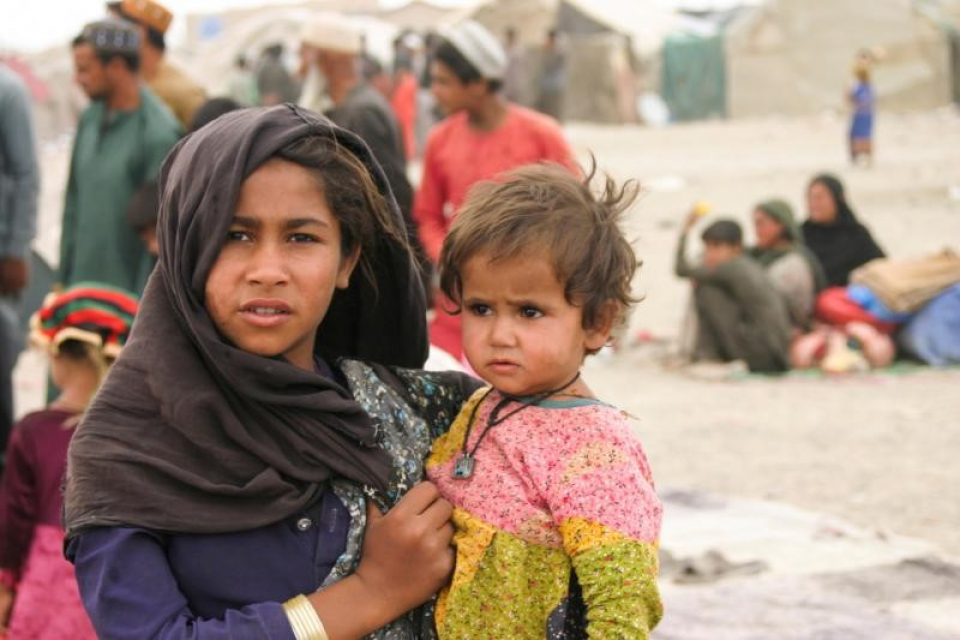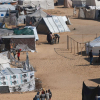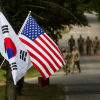By Moeed Yusuf
Peace Is Possible Only If the World Engages With the Taliban
President Joe Biden was right to end the U.S. military mission in Afghanistan. The regime in Kabul was clearly unable to sustain itself, and propping it up with billions more dollars would have only delayed its inevitable collapse. In fact, given the Afghan society’s historical aversion to foreign occupations, there was never going to be a military solution to the conflict that was in the United States’ favor. That is why Pakistan had been advocating for an inclusive diplomatic settlement ever since the negotiations known as the “Bonn process” began following the U.S. invasion in 2001.
Today, Afghanistan faces a choice: it can either walk the arduous path of peace or revert to civil unrest. The latter will have catastrophic repercussions for the Afghan people and spillover effects for the neighborhood and beyond. The spread of refugees, drugs, weapons, and transnational terrorism from a destabilized Afghanistan does not serve the interests of the Afghan people or the rest of the world, most of all Pakistan. Which of the two outcomes materializes will have as much to do with how the international community engages with Afghanistan’s new political reality as it does with how the Taliban choose to rule their country.
WHAT PAKISTAN WENT THROUGH
Apart from the Afghan people, Pakistan has been the greatest victim of the wars in Afghanistan. The Soviet invasion in 1979 and the subsequent U.S.-led military campaign after 9/11 were not of Pakistan’s making. Yet our society, polity, and economy have borne the brunt of the conflict over the last four decades.
In 2001, Pakistan joined the U.S. war on terrorism against the very same actors who were hailed as freedom fighters when Washington and Islamabad together trained and backed them to defeat the Soviets in the 1980s. After the 9/11 attacks, American leaders issued an ultimatum to Pakistan’s military dictator, General Pervez Musharraf, that he was either “with us or against us.” Under pressure, Musharraf provided the United States and its partners with virtually unconditional support, including access to Pakistan’s air bases and ground and air supply routes, and helped arrest hundreds of members of al Qaeda.
Musharraf’s post-9/11 decision to launch an internal military campaign against Afghanistan’s erstwhile freedom fighters, many of whom had deep cultural and ethnic affiliations with tribesmen in the Pakistani-Afghan border regions, resulted in a massive insurgency against the Pakistani state. Over 50 militant groups sprang up, seeking to punish Pakistan for collaborating with the United States. They targeted our cities and massacred our children; 3.5 million civilians were displaced from their homes at the height of this onslaught. In the last 20 years, Pakistan has suffered over 80,000 casualties as a result of terrorist attacks and over $150 billion in economic losses.
The cost of providing for Afghan civilians fleeing war in their home country has also largely fallen on Pakistan. We host approximately four million Afghan refugees even today; this is down from a peak of well over five million in the 1980s. Furthermore, Afghanistan’s chaos brought a “Kalashnikov culture” and narcotrafficking to Pakistan: our country’s addiction rates rose nearly 50 times during the 1980s.
Yet Western governments continued to accuse the Pakistani state of being duplicitous and asked us to “do more” to turn the tide of the war in Afghanistan. Given the sacrifices Pakistan was making on a daily basis, Pakistanis found the Western stance preposterous—they believed we could do no more without risking our very survival as a modern nation-state.
This disconnect colored the Pakistani-U.S. partnership for the better part of the last two decades. At its core, the divide stemmed from a divergence of views on how to end the war and bring peace to Afghanistan. The United States’ solution was to achieve a total victory over the Taliban. Even when Washington began considering negotiations with the group, many American officials saw it as a means of creating internal fractures within the Taliban rather than negotiating an evenhanded deal.
The Pakistani government spoke hard truths to the United States about the folly of its plans. Our position was driven by our deep understanding of the local context and the antipathy among Afghans regarding the foreign occupation of their country, which made it impossible for them to see the post-9/11 nation-building enterprise as indigenous. As early as 2002, Pakistan urged the United States and its NATO allies to recognize that al Qaeda had been dealt a severe blow and that, even as the Western powers continued their mission against international terrorist groups, they needed to recognize that the Taliban were a political reality in Afghanistan. A decade ago, when U.S. troop numbers were at their peak, Pakistan counseled using this leverage to negotiate an acceptable political settlement to the war. Washington ignored this advice, and talks never became the principal pillar of U.S. strategy.
Many Western governments turned a blind eye to their and the Afghan government’s failures, which were helping resuscitate the Taliban. Nevertheless, Pakistan engaged with the government in Kabul with sincerity of purpose. For instance, in response to complaints from the U.S. and Afghan governments that Taliban fighters were able to cross the Afghan-Pakistani border freely and find sanctuary in our country, Pakistan repeatedly offered the most logical solution: coordinated border management and visibility. Our proposals ranged from formal standard operating procedures and military liaisons for border management, fencing the entire border, and working together to block more than 60 informal border crossings to installing biometric controls to keep track of all cross-border movement. Pakistan later advocated a formal visa regime, moving away from the thousands of daily informal crossings that are customary for tribes and families who have members on both sides of the border or livelihoods that transcend the border.
All of Pakistan’s requests were turned down, ignored, or actively resisted. For instance, as early as 2007, Afghan authorities physically tore down border biometric systems that Pakistan was installing; the flimsy pretext given was that Afghanistan did not recognize the international border and was therefore opposed to physical controls.
It stands to reason that if the porousness of the border was really the Afghan government’s chief concern, it would have moved swiftly to help Pakistan monitor it effectively. The reason this did not happen was because—as the collapse of the government of former President Ashraf Ghani has now proved—Kabul knew that the real reasons it was losing ground to the Taliban were its own governance failures, its massive corruption, and the consequent lack of credibility of the post-9/11 Afghan state structure in the eyes of the average Afghan. The government in Kabul was unwilling or unable to fix these internal failures, so it shifted attention and blame onto Pakistan. This also suited countries that were pouring billions of dollars into Afghanistan with little to show for it in terms of defeating the Taliban.
The focus on the border also masked the reality that terrorists based in Afghanistan were collaborating with our archrival, India, and with elements in the Afghan intelligence services to regularly carry out attacks inside Pakistan. As Pakistan publicly detailed in a report released last year, India ran as many as 66 training camps in Afghanistan for groups such as the Pakistani Taliban and other militant organizations active in our western province of Baluchistan. With Indian support, these groups conducted targeted killings across Pakistan and high-profile attacks on Pakistan’s largest stock exchange, a major university, and a luxury hotel in the port city of Gwadar, among many others. Simultaneously, India worked to taint Pakistan’s reputation through an orchestrated propaganda campaign, using fake news networks to perpetuate a diversionary narrative that sought to blame Pakistan for Afghanistan’s failings.
Meanwhile, the United States kept pressing for Pakistan to further escalate its own military campaign against the Afghan Taliban. The truth, however, is that the group had no organized presence in Pakistan and military action against a few dispersed individuals—who may from time to time have managed to melt away among the thousands of Afghan refugees—would not have changed the outcome in Afghanistan but would have left thousands more Pakistanis martyred. An escalation was therefore unacceptable to us, as we repeatedly conveyed to the United States for over a decade. Our alternative of leading with a political dialogue that would have forced all sides to compromise, supplemented by military and other tools as needed, would have produced a naturally inclusive government while ending the conflict years earlier. And yet every time we raised this, we were seen as insincere.
The rapid collapse of Ghani’s administration has left no doubt that the government’s failures were not of Pakistan’s making. Corruption, bad governance, the refusal of Afghans to stand behind their government and state, and the choice of the 300,000-strong Afghan National Security Forces not to fight against a lightly armed insurgency lie at the heart of the return of the Taliban. Shockingly, some voices in Washington and other Western capitals continue to scapegoat Pakistan for this failure. But blaming Pakistan is not only factually incorrect—it also undermines the spirit of international cooperation necessary to end the cycle of violence that has devastated Afghanistan.
THE WAY FORWARD
Afghanistan deserves peace and prosperity, and a blame game among international actors will not get us there. Nor will a repeat of the mistakes of the 1990s, when the United States abandoned Afghanistan and sanctioned Pakistan, its close ally throughout the 1980s, once the Soviets had been driven from Kabul. This isolated the region as international assistance and attention disappeared, placed Afghanistan on a path to civil war and economic meltdown, and strengthened international terrorist outfits—eventually culminating in the 9/11 attacks. Although ordinary Afghans and Pakistanis will always face the greatest risks from instability inside Afghanistan, mass migration flows and terrorism threaten the entire world. It is therefore in every country’s interest to prevent history from repeating itself.
The prudent way forward is for the international community to engage constructively with the new government in Kabul. The goal must be to create the conditions for Afghan civilians to earn a respectable livelihood and to live in peace. This will require the international community, especially the countries that were present in Afghanistan for two decades, to play a positive role in leveraging its influence to further the cause of peace and stability.
Pakistan has been at the forefront of international humanitarian efforts since the fall of Kabul. It has helped evacuate approximately 20,000 foreign citizens and Afghans from the country and has created an air and land bridge to channel emergency supplies to the country. These efforts are important, but diplomatic engagement with Afghanistan must go much further. Afghanistan does not have the resources or the institutional capacity to stave off economic disaster on its own. In order to ensure a durable peace, the international community must determine the means through which development assistance can be provided while ensuring that its concerns about the situation in the country are addressed. But given the precarious humanitarian and economic situation in Afghanistan, time is of the essence. A wait-and-see approach, although more politically tenable for many countries, would be tantamount to abandonment.
Pakistan’s expectations of the new government are no different than those of Western governments: Pakistan wants a state that is inclusive, respects the rights of all Afghans, and ensures that Afghan soil is not used for terrorism against any country. Unlike in the 1990s, the Taliban have repeatedly stated their interest in continued engagement with the world. This is an opportunity for the international community. The leverage generated through assistance and the legitimacy the Taliban will derive from it can be used to secure inclusive governance from the new administration.
Over the past month, Pakistan has led diplomatic initiatives with Afghanistan’s immediate neighbors and other countries in the region to discuss the way forward. We will continue these efforts. However, Western diplomacy needs to be better connected with regional initiatives to forge a common agenda for engagement and decide on the multilateral and bilateral avenues available to channel assistance. A starting point could be a major donor conference where regional players and Western countries sit down together and draw up specific plans for humanitarian and economic relief. An understanding is also required on the terms of the release of the Afghan central bank’s reserves, most of which are held by the United States. Such a forum could also be used to encourage countries that have unfinished development projects in Afghanistan to consider completing them for the benefit of the Afghan people.
A coordinated global approach will reduce the risks of international divisions over how best to engage the Taliban. Although it is important to remain realistic about what is achievable in the present context, this approach will improve the prospects for an outcome that benefits the average Afghan and is acceptable to the international community.
As Pakistan’s national security adviser, my job is to advocate policy options that will protect my country. The position I have articulated here is informed by the fundamental reality that for Pakistan, disengaging from Afghanistan is not an option. The two countries share a more than 1,600-mile border and cultural links that stretch back centuries. These geographical and societal connections compel Pakistan to advocate for peace in Afghanistan, as instability there risks spilling over into our country. The Pakistani Taliban, the Islamic State, and other anti-Pakistani groups in Afghanistan cannot be allowed to harm Pakistan. Nor are we in a position to accept more Afghan refugees, who will inevitably be driven onto our soil by another spasm of violence in their home country.
We are also acutely sensitive to the fact that the livelihoods of millions of Afghans are linked to Pakistan. Being landlocked, Afghanistan depends on Pakistan for trade and transit. The country’s geographical position could become an advantage if it transforms itself into a transit hub that connects Central Asia to Pakistan’s warm waters. The Ghani government had stalled these possibilities, snubbing Pakistan’s offers of more streamlined trade and economic cooperation and the fast-tracking of connectivity projects with Central Asia.
Such connectivity is not only key to Pakistan’s geoeconomic vision; it also corresponds with the U.S.-led regional vision of establishing economic linkages among Afghanistan, Pakistan, and Uzbekistan. Multiple connectivity projects are already underway, including plans to establish energy and electricity inflows from Central Asia, a trans-Afghanistan rail project from Uzbekistan, and projects to upgrade the road infrastructure to create a viable corridor of connectivity. U.S. and other international and regional investments in energy, minerals, and infrastructure could potentially herald a new era of cooperation in the region and buttress peace efforts.
While Pakistan can and will assist in pushing Afghanistan in a positive direction, it alone cannot guarantee the outcomes we all desire. Pakistan does not wield any extraordinary influence over the new rulers in Kabul, as both monetary assistance and legitimacy for the Taliban can come (or not) only from the world’s major powers. Coordinated engagement involving the Western powers, China, Russia, Middle Eastern countries, and Afghanistan’s immediate neighbors, however, would maximize the chances of realizing our common objectives in Afghanistan.
A LASTING PEACE
Pakistan is committed to peace in Afghanistan and in the region. We have lost much in blood and treasure to support the war next door and have repeatedly demonstrated our commitment to ensuring our neighbor’s stability and economic prosperity. We worked with the United States to facilitate the peace process in Afghanistan, confronted the menace of terrorism at home, hosted millions of Afghans for over four decades, and pursued a policy of strategic restraint despite aggressive provocations from spoilers such as India. Today, Pakistan is seeking to foster economic interdependence through regional connectivity and development partnerships while settling political disputes amicably.
Afghanistan could serve as a model for this regional vision, but the international community must also play its part. By engaging with the new Afghan authorities now, the United States and other global powers can avert a humanitarian crisis, help Afghans live in peace, and ensure that the threat of terrorism emanating from Afghan soil is ended once and for all. This is not only their collective responsibility; it is also in their self-interest.
Of course, the new Taliban authorities will ultimately have to prove that they intend to govern Afghanistan in a more inclusive manner. However, history will judge us very poorly if we do not create the most conducive environment possible to push them in a healthy direction—for the collective benefit of Afghans and the world. Failure to do so will leave Pakistan to bear the brunt of any negative spillover from Afghanistan. We have already carried more than our share of the burden.

By engaging with the new Afghan authorities now, the United States and other global powers can avert a humanitarian crisis, help Afghans live in peace, and ensure that the threat of terrorism emanating from Afghan soil is ended once and for all.
















